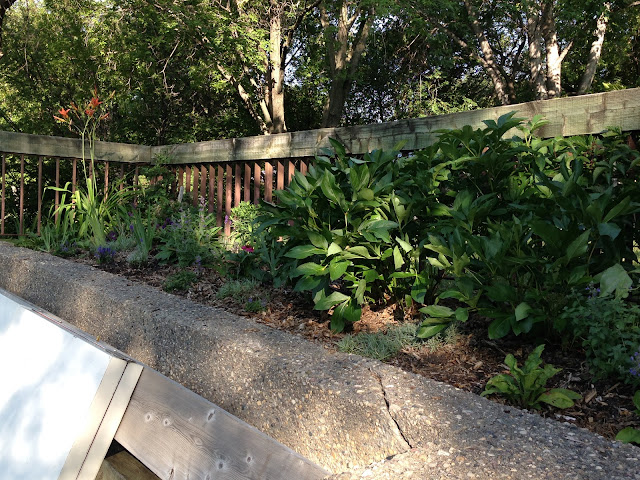Since their initial planting in 2013, the Left and Right Entrance Beds had started to lose their vibrancy. Last winter took a toll on plants in many gardens including our Entrance Beds. The left bed lost its yarrow and most dianthus (pinks). The right Entrance Bed has suffered over the years from underplanting": few plants scattered across wide areas of mulch. It was time for a refresh.
 |
| The refreshed Left Entrance Bed |
Here are all the refreshed plants in the Left Entrance Bed:
|
| Bachelor's
Button |
| 'Bowl of Beauty' Peony |
| Clematis Jackmanii |
| Creeping Speedwell |
| Daylily |
| Dropmore Blue Catmint |
| Dwarf Spike Speedwell |
| English Lavender |
| 'Frosty Fire' Pink |
| Iris |
| Perennial Sage |
| Powwow Wild Berry Coneflower |
| Purple Dome Aster |
| Three Flowered Avens |
 |
| The refreshed Right Entrance Bed |
|
|
Here are all the refreshed plants in the Right Entrance Bed:
| Black
Leaved Thrift |
| Bleeding Heart |
| 'Bridal Falls' Hosta |
| Dropmore Blue Catmint |
| Dwarf Spike Speedwell |
| English Lavender |
| 'Gold Standard' Hosta |
| Iris |
| Little Trudy Catmint |
| 'Loraine
Sunshine’ Heliopsis |
| McKana Giant Columbine |
| Mourning Widow Cranesbill |
| Nannyberry |
| Ostrich Fern |
| Powwow Wild Berry Coneflower |
| Prickly Rose |
| Virginia Creeper |
| Weigela |
| 'Wishing Well' Hosta |
|
As we have learned from our native plant beds, we intermixed species while recognizing that shorter plants should be closer to the viewer, larger ones further back. From a techniques perspective, we positioned the taller ones first so that we could gauge their impact on the overall viewing of the planting area. Our goal is to deliver an impact of lushness to the viewer. Nothing is more depressing than seeing a single plant stuck in the middle of a sea of mulch, unprotected from the wind and the sun.
Finally, the plants we selected blossom at different times during the year, May through September. There is always something of interest to see in the garden.






